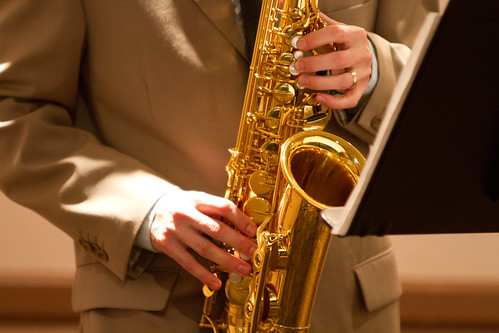Having said that, there’s a difference between being able to squawk out “Hot Cross Buns” and playing music other people actually want to listen to. Learning to play saxophone well requires just as much time and practice as any other instrument.
And how long is that? There are too many factors involved to give a definite timeframe, but most people can play at a “performance level” (in other words, well enough you won’t be embarrassed playing in front of your friends) within 2-3 years. This is assuming you’re starting with no prior music training and that you’re able to dedicate 3 hours a week or more to practicing your instrument.
Obviously, this isn’t a guarantee. A dedicated beginner might be ready to blow a blues solo in a year or less—and, on the other end of things, you’ll probably never really learn the sax if you only pick it up once every few months. Let’s dig a bit deeper into the question so you can get a better idea of how long your sax learning journey will be.
Which Saxophone Are You Learning?
Saxophone is a family of instruments that come in a mix of keys and sizes—a whopping 14 total, though most people will only encounter 4 in the wild: the soprano, alto, tenor, and bari (or baritone, if we’re being formal about it).
Young learners often start with the alto because it’s relatively lightweight and easy to play and tune. For adult beginners, tenor could be a better choice for a similar reason. Its mouthpiece is slightly larger, which can be easier on your mouth muscles while you’re learning to form an embouchure.
The fingerings of all saxophones are the same, so learning to play one means you can play them all. If you eventually want to play soprano or bari, you’ll have an easier time learning the basics on a tenor or alto first. Soprano can be temperamental and requires the most finesse, while bari demands more lung power and breath control than most beginners have. Either way, they’re not recommended for sax novices.
If you’re not sure whether to start with alto or tenor, head to a music store. Even though you can’t play them yet, you can hold them and get a sense for which fits more comfortably in your hands and mouth. The easier it is for you to play, the faster you’ll be able to learn.
On a similar note, the quality of the saxophone matters, too. You’ll learn faster on an instrument that’s in good repair and made by a reputable brand. A heavily used or off-brand sax is almost guaranteed to have leaks and intonation issues. An experienced player can identify and work around these issues, but a beginner won’t always be able to tell if problems are their fault or the instrument’s, and that makes it hard to fine-tune your technique.
A Note on Reeds
The reed on a saxophone is the thin strip of wood that attaches to the mouthpiece. In very general terms, it’s what vibrates to generate the sound that’s amplified through the rest of the instrument. Basically, even the best sax won’t play without a functioning reed.
Reeds come in different thicknesses, indicated by a number between 1.5 and 5. The lower the number, the thinner the reed and the brighter the sound. A thin reed also vibrates more easily, meaning it takes less effort to produce a pitch. A strength of 2 or 2.5 is best for most beginners. As your mouth muscles strengthen, you can experiment with harder reeds to find the tone you’re looking for.
You’re going to break a lot of reeds. This is an unavoidable part of playing saxophone at any level. Reeds also wear out over time and will need to be periodically replaced, no matter how careful you are with them.
This recurring expense leads some learners to purchase cheaper brands or “permanent” synthetic reeds. Avoid this temptation. Similar to playing on a messed-up horn, cheap reeds make playing harder than it needs to be. You’ll learn faster (and better) if you shell out a few extra bucks for the good stuff.
Do You Need Private Lessons to Learn Saxophone?
The simple answer is no. You’ll find plenty of self-taught saxophonists out there, and many of the jazz greats like Charlie Parker and Ornette Coleman largely learned the horn on their own.
Taking private lessons can help you learn the instrument faster, though, and can prevent you from developing bad habits that you’ll need to unlearn down the line. If nothing else, knowing you’ll be expected to play that scale or etude in a few days can be a good motivator when you don’t feel like practicing. If you’re committed to learning saxophone within a certain timeframe, taking private lessons is often a smart move.
How Often Should You Practice (and For How Long)?
Learning to play a musical instrument is as much about physical conditioning as it is artistic skill. You need to train the muscles of your mouth and fingers to work perfectly in sync, and the only way to achieve that is through regular repetition.
As a beginner, the frequency of your practice sessions is more important than their length. The best approach is to start small and build. Aim to play for at least 20 minutes, at least 4 days a week, and keep to that routine for 60 days—long enough to make it a habit.
To be honest, you probably won’t be able to play much longer than 20 minutes at a time when you’re starting. A wind instrument embouchure is an unnatural position for most people’s facial muscles. Part of daily regular practice is strengthening these muscles so you can use them longer before they wear out.
The Bottom Line
Nobody should expect to learn the saxophone overnight, but anyone can do it with consistent practice. Consider your goals for the instrument, too. Where do you see yourself playing? In your buddy’s ska band? The community concert band? A public jam session at a jazz club? Those are three very different skill set with equally varied learning curves, and each requires their own level of dedication.
Regardless of your goals, the first and most important step to learning the saxophone is establishing a habit of regular practice. Once it becomes a part of your regular routine, you’ll be well on your way to playing a new instrument. Good luck!


